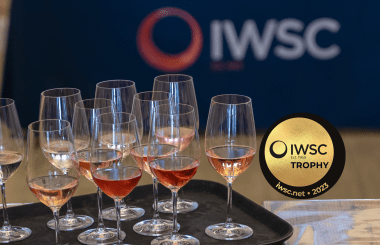IWSC 2024 Alternative Drinks Judging: Judges’ deliberations on Low & No
Low & No is one of the IWSC’s fastest growing categories, with more entries and improved quality year-on-year. We checked in with IWSC Judging Committee member Claire Warner, who oversaw the judging, and the judging panel to get their thoughts on how the category is evolving and what stood out to them.
Claire was impressed with the quality of entries in every category, “It was great to see the number of entries continue to rise and the quality improving in leaps and bounds across the range”.
Low & No Aperitifs
“The Aperitifs had some really complex botanical styles, reflecting the consumer trend towards more bitter styles of drinks,” shared Claire, “There has been an increase in entries and medals awarded, showing that the category is improving year-on-year.”
Our judges were greatly impressed with the aperitifs, even going so far as to comment “While we loved how the apperitivo bloomed and shined when mixed, some of the team would even enjoy them on the rocks when they were intense!”. Almost every entry was awarded a silver or gold medal, highlighting the quality of entries.
One high-quality entry was awarded a gold medal. The judges were quick to praise its “appealing orange colour, bitter orange and herbaceous nose of high intensity.”
Low & No De-alcoholised Wine
The de-alcoholised wine category is one of the IWSC’s fastest growing categories, with Claire Warner noting that “the two days were really dominated by wine and the developments that we're seeing in technology and that real distinction between wines that have been de-alcoholised and wines that have not been fermented, and some of the real sort of flavour profile experience differences that come from those two quite distinct techniques. There were some really good results for both of those too with some good solid silver medals and a few golds too!”
The judges were impressed with several of the de-alcoholised wines, awarding gold medals to two standout sparkling entries. “Sparkling dry wines were quite good across the board with some good silvers and consistent quality. The sparkling Shiraz was a show stopper, showing varietal typicity, nice mouthfeel and exceptional drinkability. This is the standard and as the rest of the category evolve to this level it will be very interesting indeed. The future is bright!”
Claire echoed these statements saying “we’ve seen some really great sparkling wines, which always seem to do very well at the judging. The producers seem to do a great job at showcasing the complexity of the wines because of the effervescent. We are seeing a lot more elegant and sophisticated flavours coming through.”
De-alcoholised red wine stood out to our panel, with the category being awarded several bronze medals and a high-scoring silver medal winning Merlot that our judges praised for it’s “well-balanced acidity and clean palate”.
De-alcoholised wine blends also performed highly, with the judges awarding 3 bronze medals, 3 silver medals and a gold medal. The gold medal was awarded to a Bellini entry that had “big peach notes with a good fizz and great balance of sweet and sour undertones.”
Low & No Non-fermented Wine
The second Low & No wine category includes wine that has not gone through any fermentation. The judges praised this new category, “We found that splitting the wine into alcohol free and de-alcoholised has helped make a distinction between the two”.
Non-fermented wines were awarded a high amount of bronze medals and several silvers awarded to those that impressed the judges. Two silvers were awarded to a sparkling white that the judges found appealed to them with its “sweet and floral palate with a pleasing light fizz”. While the other silver was awarded to a Prosecco alternative that the judges noted was “light, bright and fruity”.
Low & No Beer
The Low & No beer category has been consistent this year, with judges praising several good examples of different styles, with every entry winning a medal. “Beers have been fairly consistent this year, with some pretty good examples of styles. Good to see the category creating a more consistent product across the board. No 'no medals' across the category is a great result!”.
Claire highlighted how far the category has come in a relatively short time. “Beer continues to be a huge category, but again, there’s been more improvement in this area too. We saw some medals for things which wouldn’t have even been in the running last time. I think there's just more nuance in those styles and there's a lot more choice for the beer drinker, which is great to see!”.
The judges awarded silver medals to particular stand outs. These include a Lemon Lager that reminded the judges of a shandy-style beer, and a Helles Lager that had a “great appearance with a sweeter Helles style and controlled bitterness, followed by a nice balance of hops and grain, round typical Helles finish, and a superb balance.”
Low & No RTDs
Our panels were impressed with the quality of Low and No RTDs this year, with more entries and a bigger focus on agave alternatives, reflecting the popularity of agave spirits in the trade.
“We've seen more creativity in the way the entries have been produced and great use of techniques to produce flavours. Year-on-year, it's clear there's been an improvement. It's clear to see that we've moved beyond artificial only and the flavours being delivered are either authentic, or at least closer to the true representation of what they are,” shared the judges.
One of the highlights for the judges was a RTD Paloma that was awarded gold. The judges were particularly impressed with the “nice, bright citrus nose with a strong tequila note.”
Low & No Dark Spirit Alternatives
We saw an increase in Low and No dark spirit alternative entries this year, something Claire was pleased to see.
“We saw a lot more low/no dark spirits alternatives coming through, producers are getting more creative and crafting rums, tequilas and Bourbon whiskey alternatives, broadening the option for consumers to engage with scotch/rum/tequila cocktails,” Claire shared.
Indeed the Scotch whisky alternatives performed well this year, winning several bronze medals. The judges highlighted the “beautiful true authentic whisky nose, malt fresh cut grass, bready, caramel” on one of the entries, also noting “it has been great to see the breadth of entries expanding year-on-year and the base line quality increasing with it.”
Low & No Mixers
Mixers are a popular section of the Low and No category, something reflected in the quality of entries. Our judges noted how bold and innovative the standard was this year.
“Producers are being very playful in this space, using flavours that you wouldn’t expect to see in a mixer but have been used to great effects and will add another layer of choice for consumers at home or in bars, to either use them with non-alcoholic spirits or to lengthen full-proof spirits,” shared the judges.
Claire Warner agreed, stating “I was really pleased to see so much innovation in mixers and cordials. A lot of quite new to the world flavours in that category, which has been fun for the panel and while some of them have been challenging, they caused a debate which was great.”
One gold-winning mixer surprised the judges with a “very enticing fresh juicy pineapple on the nose followed by wonderful caramelised pineapple notes on the palate. Well balanced and fresh tasting.”
Another gold-medal-winning mixer was a Bloody Mary spice mix that the judges praised for how well balanced it was. “Great level of spice on the palate that opens up well to a warming finish, strong taste with a balanced, spicy kick!” shared the judges.
With our Alternative Drinks judging now concluded, stay tuned for the full results announcement on 29 May.



